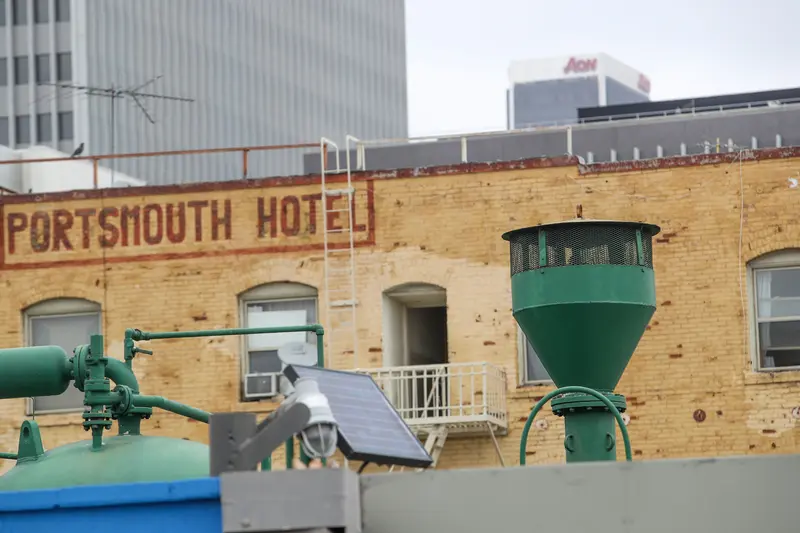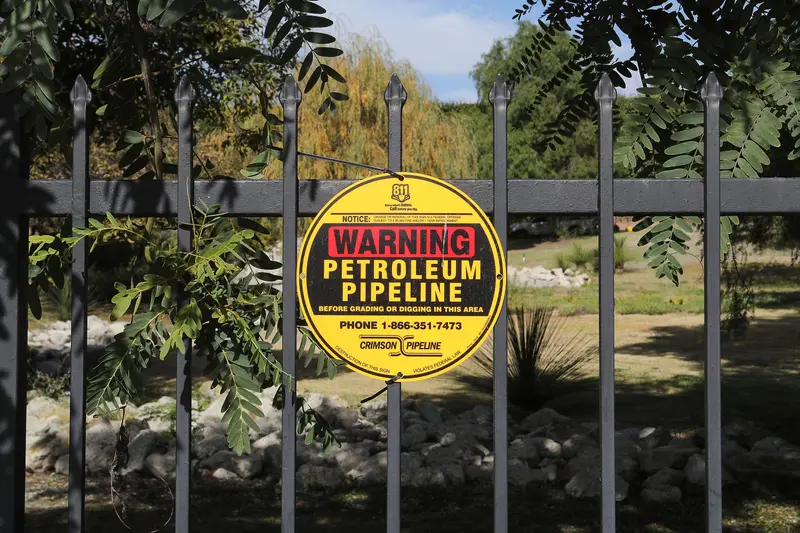This story was co-published with The Desert Sun, a former member of the ProPublica Local Reporting Network.
A south Los Angeles oil producer has been ordered by California’s top oil regulator to pay almost $1.5 million in fines for nearly 600 violations of state regulations, including continuing to operate aging, dangerous wells for nearly a year after losing approvals.
The actions against Nasco Petroleum come two months after The Desert Sun and ProPublica reported on lax enforcement and worsening transparency by the California Geologic Energy Management Division, including at a Nasco drilling site that sits next to low-income housing. Residents of the housing site have worried for years about potential explosions, fires and health impacts from leaks and fumes.
Nasco did not respond to requests for comment for this article; during reporting for the earlier piece, a Nasco employee said its wells were operating with no problems, but the owner did not respond to requests for comment. All four wells at the downtown LA site named in the order were still listed as active on the agency’s website as of Friday. The company has the right to appeal within 15 days.
It’s unclear if and how CalGEM will follow up on the hefty fines. Despite gaining tougher enforcement powers in recent years, the agency has struggled to use them. In October 2019, it trumpeted a $2.7 million fine against Chevron for a series of oil spills that Gov. Gavin Newsom had toured. Chevron appealed, and as of March the fine had not been paid. An agency spokesperson said Friday in an email, “There are no updates at this time,” about the Chevron fine, and gave little additional comment on the latest fine against Nasco. The governor’s latest budget proposal includes funding for 26 new positions over the next three years to strengthen enforcement.
Community organizers who have fought for a decade to end oil extraction in urban neighborhoods were gratified by the large penalty, and said they hope it will be collected.
“I’m glad that CalGEM is being more aggressive in using its enforcement authority to go after deadbeat, problematic oil companies like the Nasco site that put community members’ health and safety at risk,” said STAND-LA coalition coordinator Eric Romann. But, he added, “I would say that there’s evidence to suggest CalGEM’s bark is worse than its bite. If it’s issuing fines in problem areas that are clearly in violation and not even collecting them, it’s deeply concerning.”
The Desert Sun and ProPublica investigation found that although CalGEM has received funds for dozens of new staff and a shift in mission to focus on safety and the environment, many companies continue to violate California’s oil and gas rules with impunity.
In 2020, CalGEM said, it issued $191,669 in civil penalties and collected zero. Between 2018 and 2020, CalGEM issued 66 enforcement orders. Of those, just 11 had been complied with, while the vast majority remained outstanding, according to agency records and responses. State Sen. Henry Stern, D-Los Angeles County, has proposed legislation that would require CalGEM to make inspection reports and other enforcement documents available to the public on its website.

At the Nasco site in downtown Los Angeles, Friday’s order by oil and gas supervisor Uduak-Joe Ntuk caps years of efforts by the agency to force the company to fix or shut down what an internal investigation called “bad” wells. In 2016, inspectors flagged problems. In 2019, an investigative unit at CalGEM said Nasco was injecting huge amounts of water into well bores there above the legal pressure limits, aiming to push more crude out of what is known as the Los Angeles Downtown Oil Field.
Similarly intense injection pressure led to a major oil spill in 2006, after a nearby well bore operated by Nasco’s predecessor ruptured. Hot crude and oily waste bubbled up from underground, filled an apartment building basement, oozed out of manhole covers and buckled sidewalks. More than 130 low-income tenants were evacuated.
The pressure wasn’t the investigators’ only concern. They also noted in an urgent report to a manager that a number of bad wells had been left unfixed for years, and posed “immediate” risks to drinking water aquifers. In July 2020, the agency notified Nasco that the company no longer had legal approvals to inject into the wells, which run thousands of feet under downtown Los Angeles.
Wednesday’s order says Ntuk and his staff “determined that Nasco injected above maximum allowable surface injection pressure into the Wells in violation of Regulations”; that “Nasco failed to cease injecting despite losing approval to inject ... on July 15, 2020”; and that “Nasco did not submit a pipeline management plan as required.”

Each day that Nasco continued to inject without approval is a separate violation. Ntuk ordered the company to pay a civil penalty of $1,449,000.
Romann, the community organizer, said the ongoing concerns about the Nasco site are one more sign that both city and state regulators should ban oil operations near homes, schools and other sensitive areas.
About 250,000 Angelenos live within half a mile of an active oil or gas extraction site. Statewide, 2.1 million people live within a mile of active oil wells, which use dangerous chemicals and can emit toxic pollutants.
Newsom directed CalGEM to study a possible public health buffer between schools and homes and risky fossil fuel extraction sites, but that proposal and another to phase out drilling completely by 2045 have drawn heavy criticism from oil companies, their lobbyists and Central Valley legislators in particular. A draft buffer rule was expected by the end of 2020, but was pushed back by CalGEM until this spring and has still not been released. Separately, the Los Angeles City Council is studying changing zoning to outlaw such drilling.
By law, CalGEM can issue an emergency order to stop operations if it determines there is an immediate risk. Agency spokesperson Donald Drysdale said “no emergency order was necessary” for the Nasco site.
Romann said, “For us it’s more ammo for our argument that these sites should just be shut down.”
Janet Wilson, a 2020 ProPublica Local Reporting Network member, is senior environment reporter for The Desert Sun/USA Today network. She can be reached at [email protected] or @janetwilson66.











